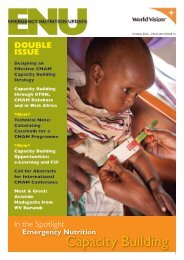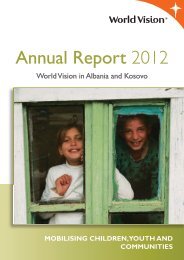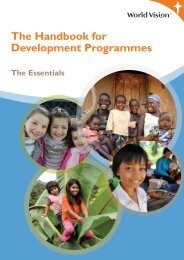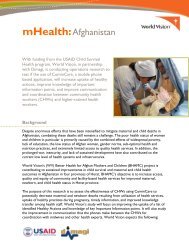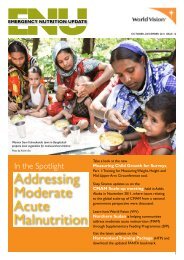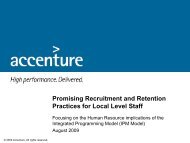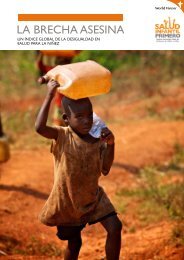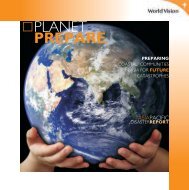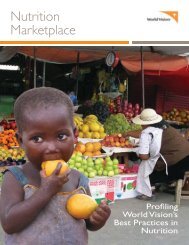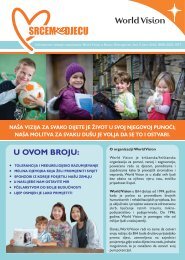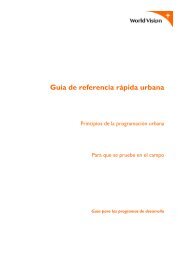aimed at providing equal opportunities in <strong>education</strong> <strong>for</strong> all students, including those <strong>with</strong> <strong>disabilities</strong>.Inclusive <strong>education</strong> was a complex process that first and <strong>for</strong>emost, needed <strong>to</strong> be recognized and acceptedby any Albanian society system and <strong>the</strong>n implemented. It required undertaking of radical changes. Changespertaining <strong>the</strong> legal framework of <strong>education</strong>, <strong>the</strong> commitment of <strong>education</strong> authorities and schooladministrations <strong>to</strong> increase <strong>the</strong> participation of all students in curriculums, <strong>to</strong> provide sufficient supportservices, qualified staff, teachers <strong>with</strong> proper training, and above all, <strong>to</strong> create a welcoming and safe schoolatmosphere.Albania in this period was not yet ready <strong>to</strong> implement <strong>inclusive</strong> practices in <strong>education</strong>. We can say that only<strong>the</strong> first steps had been taken in this direction.Data if we refer <strong>to</strong> <strong>the</strong> work results from <strong>the</strong> application of multi-year projects implemented in <strong>the</strong> regionsof Tirana, Korça, Vlora, Berat and Gjirokastra by Save <strong>the</strong> Children in collaboration <strong>with</strong> <strong>the</strong> Association“Ndihmoni Jetën” and MEDPAK have shown that students <strong>with</strong> <strong>disabilities</strong> that have participated in <strong>inclusive</strong><strong>education</strong> have:• Higher academic achievements• Higher self confidence• Better social skillsIt is believed that <strong>the</strong> <strong>education</strong> of <strong>children</strong> <strong>with</strong> <strong>disabilities</strong> alongside <strong>the</strong>ir peers, facilitates <strong>the</strong>ir access<strong>to</strong> general curriculum. Inclusion creates benefits <strong>for</strong> o<strong>the</strong>r students as well, who learn <strong>to</strong> understand andinteract better <strong>with</strong> o<strong>the</strong>r individuals that have special characteristics.first, <strong>the</strong> <strong>inclusive</strong> <strong>education</strong> re<strong>for</strong>m sought legal framework changesin <strong>education</strong>Albanian legal framework of this field is relatively new, compared <strong>to</strong> o<strong>the</strong>r states’ legislation. The first lawthat addresses from <strong>the</strong> social perspective individuals <strong>with</strong> <strong>disabilities</strong>, is <strong>the</strong> Social Assistance Law adoptedon 05/18/1993.From a different perspective, it is noteworthy that <strong>the</strong> first law pertaining individuals <strong>with</strong> <strong>disabilities</strong> inour country, is <strong>the</strong> law of 1960, which was modified and amended several times by <strong>the</strong> Parliament. Theinterpretation of <strong>the</strong> law clearly shows that individuals <strong>with</strong> <strong>disabilities</strong> were treated only through <strong>the</strong>medical model, leaving out <strong>the</strong> psycho-social context in which <strong>the</strong>y lived, and <strong>the</strong> importance of <strong>the</strong>irintegration in<strong>to</strong> society. Applying <strong>the</strong> medical model became more apparent <strong>for</strong> all institutions that care<strong>for</strong> individuals <strong>with</strong> <strong>disabilities</strong> that were under <strong>the</strong> authority and jurisdiction of <strong>the</strong> Ministry of Health. Thisapproach is also evidence of anti-social attitudes that <strong>the</strong> Albanian society displayed against individuals<strong>with</strong> <strong>disabilities</strong>. Rights of individuals <strong>with</strong> <strong>disabilities</strong> issues, were dead issues. These <strong>right</strong>s were neverspoken of, and moreover <strong>the</strong>re was no concrete ef<strong>for</strong>t <strong>to</strong> protect those <strong>right</strong>s. The society did not respect<strong>the</strong> principle of human diversity. Discriminative attitudes <strong>to</strong>wards this target group, starting from among<strong>the</strong> family and <strong>the</strong>n beyond <strong>the</strong> household “walls”, aggravated immensely <strong>the</strong> situation of <strong>children</strong> <strong>with</strong><strong>disabilities</strong>. For <strong>the</strong> family, <strong>the</strong> birth of a child <strong>with</strong> <strong>disabilities</strong> was a great mishap, which should be isolatedand kept secret <strong>with</strong>in its confinements.The experts of this field testify that during <strong>the</strong> dicta<strong>to</strong>rship, <strong>the</strong>re was a tendency <strong>to</strong> hide <strong>the</strong> existence ofdisability diagnoses. The strong erroneous propaganda denying <strong>the</strong> existence of disability diagnoses, is ano<strong>the</strong>rexample of discrimina<strong>to</strong>ry and ignoring ways <strong>the</strong> problems which <strong>children</strong> <strong>with</strong> <strong>disabilities</strong> were faced. Thetendency not <strong>to</strong> recognize and treat as such <strong>the</strong> diagnoses that <strong>children</strong> had, lead <strong>to</strong> lack of services and<strong>the</strong>ir ineffective treatment. It is noteworthy that under this pressure combined <strong>with</strong> <strong>the</strong> nuances of politicalideologicalera, realization of researches and realistic assessments of <strong>the</strong> situation, conditions and treatment of<strong>children</strong> <strong>with</strong> <strong>disabilities</strong>, was an u<strong>to</strong>pia.34 The <strong>right</strong> <strong>to</strong> Inclusive Education <strong>for</strong> <strong>children</strong> <strong>with</strong> Disabilities
Changes that accompanied <strong>the</strong> early 1990s, brought <strong>with</strong> <strong>the</strong>m <strong>the</strong> first changes in <strong>the</strong> treatment ofindividuals <strong>with</strong> <strong>disabilities</strong>, ranging from <strong>the</strong> broader legal framework and fur<strong>the</strong>r on. Many nongovernmentalorganizations offered <strong>the</strong>ir financial support and technical and professional assistance in terms of treatmen<strong>to</strong>f <strong>children</strong> <strong>with</strong> <strong>disabilities</strong>. It began <strong>to</strong> be applied <strong>the</strong> social model of treatment of disability, along <strong>with</strong> <strong>the</strong>medical one. The most vivid example of this change was <strong>the</strong> recognition of <strong>the</strong> <strong>right</strong>s of <strong>the</strong>se individuals.The state finally recognized <strong>the</strong> <strong>right</strong> of <strong>the</strong>se individuals <strong>for</strong> support and social assistance. This was madepossible by <strong>the</strong> amendment of Law No. 7692 of 03/31/1991 on Major Constitutional Provisions. In Article31 of this Law it is stated: Under a certain system, everyone is entitled <strong>to</strong> social security in old age or whenit has a handicapLaw No. 7710 dated 05/18/1993: <strong>for</strong> social support and assistance, is <strong>the</strong> first legal act that paved <strong>the</strong>way <strong>for</strong> all o<strong>the</strong>r legal regulations in favor of treatment of individuals <strong>with</strong> <strong>disabilities</strong>. Following <strong>the</strong> passingof this law, <strong>the</strong> decree of <strong>the</strong> Council of Ministers No. 457 dated 10/08/1995: “On disability perquisite”entered <strong>for</strong>ce. These decrees covered individuals <strong>with</strong> <strong>disabilities</strong> or those who had become so <strong>with</strong>in 21years of age (or up <strong>to</strong> 24 if <strong>the</strong>y were continuing <strong>education</strong>), in case that <strong>the</strong>ir disability was acknowledgedby MLDWA.To promote and encourage <strong>the</strong> involvement of <strong>the</strong>se individuals in <strong>the</strong> <strong>education</strong> system aiming atexpanding <strong>the</strong>ir knowledge, <strong>the</strong> state has allocated extra payments <strong>to</strong> individuals <strong>with</strong> <strong>disabilities</strong> whoattend middle school or university.The increase of <strong>the</strong> number of beneficiaries of social protection scheme, indicates an increase of services<strong>to</strong> this category of individuals, but it is also explained <strong>with</strong> <strong>the</strong> change of mentality and attitude of <strong>the</strong>Albanian society <strong>to</strong>wards disability.Ano<strong>the</strong>r law that is added <strong>to</strong> this legislative package <strong>to</strong> support individuals <strong>with</strong> <strong>disabilities</strong>, is <strong>the</strong> law No.8090 dated 03/28/1996 “On <strong>the</strong> status of <strong>the</strong> blind”, from which benefit all persons <strong>with</strong> full or partial lossof visibility, both congenital or acquired during life, verified by MLDWA.Ano<strong>the</strong>r law that brought innovations in <strong>the</strong> Albanian legal framework was Law No. 8092 on MentalHealth which ensured “<strong>the</strong> <strong>right</strong> <strong>to</strong> free rehabilitation and treatment in social welfare institutions, publicinstitutions of rehabilitation and <strong>education</strong>. The <strong>right</strong> <strong>to</strong> social support and services from <strong>the</strong> social worker.Issuance of this law opened <strong>the</strong> way <strong>to</strong> <strong>the</strong> practice of social work services by professionals in this field<strong>for</strong> individuals <strong>with</strong> <strong>disabilities</strong>. Article 8 of this law states: In all psychiatric rehabilitation institutions, <strong>the</strong>Ministry of Labor and Social Affairs appoints social workers who moni<strong>to</strong>r <strong>the</strong> treatment of patients from<strong>the</strong> social and protection of <strong>the</strong>ir <strong>right</strong>s perspective. In this context, <strong>the</strong> Ministry of Health also appointedsocial workers at <strong>the</strong> psychiatric specialities in <strong>the</strong> level of primary health institutions.in this context, in december of 2002 it was passed <strong>the</strong> Normative Provision which made <strong>the</strong> legalsituation <strong>to</strong> change, supporting unequivocally <strong>the</strong> <strong>right</strong> of disabled <strong>children</strong>, <strong>to</strong> be appropriately educated.The NP does not exclude any category of <strong>children</strong> from <strong>the</strong> compulsory <strong>education</strong>, regardless of <strong>the</strong>irabilities. At <strong>the</strong> same time, it provides three <strong>for</strong>ms of realization of <strong>the</strong>ir <strong>education</strong>, such as mainstreamschools, special schools and o<strong>the</strong>r institutions (e.g. home) in cases of that group of <strong>children</strong> who <strong>for</strong>various reasons can not attend nei<strong>the</strong>r mainstream school nor <strong>the</strong> special one. On this issue, article57 of this nP, chapter Xiii - “Education of Students <strong>with</strong> Special Needs”, reads as follows: [1/b] For<strong>children</strong> <strong>with</strong> <strong>disabilities</strong> of mental, physical, sensory and organic nature, <strong>the</strong> state takes care and createsopportunities and supportive structures or o<strong>the</strong>r diverse bodies <strong>with</strong>in and <strong>with</strong>out <strong>the</strong> school, <strong>for</strong> <strong>the</strong>maximum development of <strong>the</strong>ir potentials.[2] The <strong>education</strong> of <strong>children</strong> <strong>with</strong> <strong>disabilities</strong> is conducted in two ways: through <strong>the</strong>ir integration in public<strong>education</strong> schools (mainstream schools) in <strong>the</strong> framework of <strong>inclusive</strong> <strong>education</strong> and <strong>the</strong>ir treatment inseparate schools or classrooms (special), according <strong>to</strong> <strong>the</strong>ir category and specifications that <strong>the</strong>y represent,which are part of a network of public pre-university <strong>education</strong>al institutions in <strong>the</strong> Republic of Albania.The <strong>right</strong> <strong>to</strong> Inclusive Education <strong>for</strong> <strong>children</strong> <strong>with</strong> Disabilities35



